Poll: The DOA agenda?
Walz’s policy agenda faces stiff opposition.
A sleight of hand may have to outmaneuver popular policy as Governor Tim Walz tries to pull several legislative rabbits out of his hat. Minnesotans resoundingly reject key components of the controversial legislative agenda of his first term in office, according to the most recent Thinking Minnesota Poll, a quarterly statewide survey of Minnesotans sponsored by Center of the American Experiment.
Walz’s budget, gas tax, and energy mandate all appear to be under deep water in terms of public opinion.
Meeting Street Research conducted phone interviews with 500 registered Minnesota voters (including 30 percent by cell phone) on March 11-13. There is a 4.38 percent margin of error in the data.
Most endangered seems to be Governor Walz’s attempt to impose a 20-cent per gallon gas tax on drivers, giving Minnesotans the fourth highest gas tax in the country. Our data reveal that voters statewide reject the tax by a margin of 60 percent to 35 percent, with 45 percent expressing “strong” disapproval.
Minnesotans oppose the gas tax in every geographical part of the state and in every population demographic. The core Twin Cities offer the closest margin, with opponents eclipsing supporters by 47 percent to 45 percent; women aged 18 to 54 appear most sympathetic to the idea, while still rejecting it by a margin of 52 percent to 43 percent. All other regions and demographic groups reject the notion by large margins.
In partisan terms, Walz’s gas tax is popular only among socalled “base Democrats.” Base Democrats (those who say they are “strongly Democratic” in their partisan affiliation) support the measure by 67 percent to 26 percent, but “soft Democrats” give only lukewarm support (51 percent to 44 percent). Not surprisingly, Republicans reject the idea by stratospheric margins. Base Republicans oppose the gas tax 92 percent to 6 percent; soft Republicans 88 percent to 9 percent.
Perhaps most alarming for Walz’s legislative strategists is that Independents reject the gas tax by 59 percent to 34 percent. It is the rare policy initiative that can survive the intensity of such opposition.
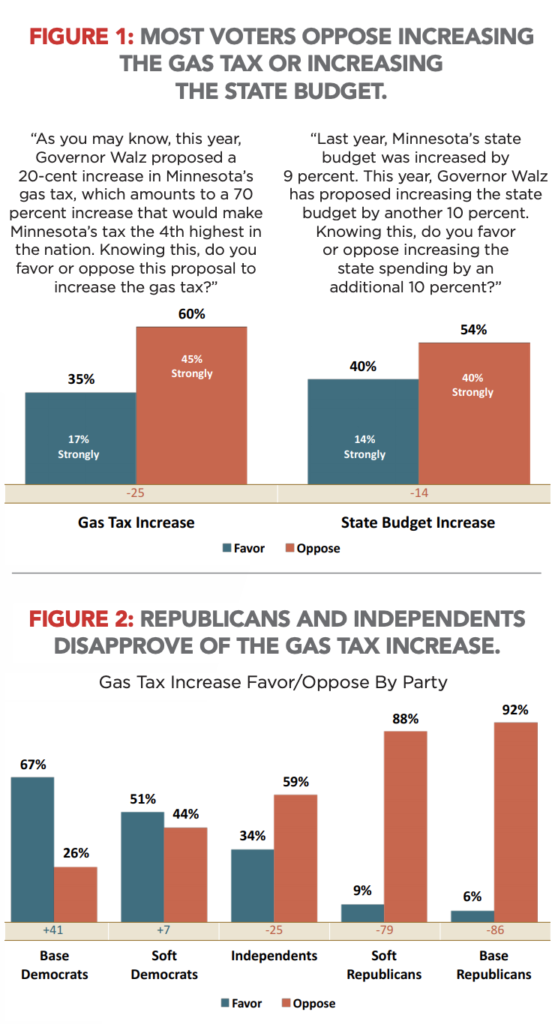
State Spending
Walz also faces steep and widespread opposition to his proposal to increase the state budget by 10 percent, which is in addition to the nine percent increase in last year’s state spending. Minnesotans oppose his spending proposal by a margin of 54 percent to 40 percent. And even that number shows little flexibility, as 40 percent “strongly” disapprove and only 14 percent “strongly” approve of his proposal. Again, base Democrats and soft Democrats provide his base, with support margins of 52 percent and 22 percent, respectively. Republicans reject his spending plan by wide margins.
In terms of geography and demographics, Walz’s spending plan is favored only in the core Twin Cities (51 percent to 42 percent) and by women aged 18 to 54 (55 percent to 36 percent). His greatest opposition is in northeast Minnesota and among women aged 55-plus, where he is opposed by two-to-one.
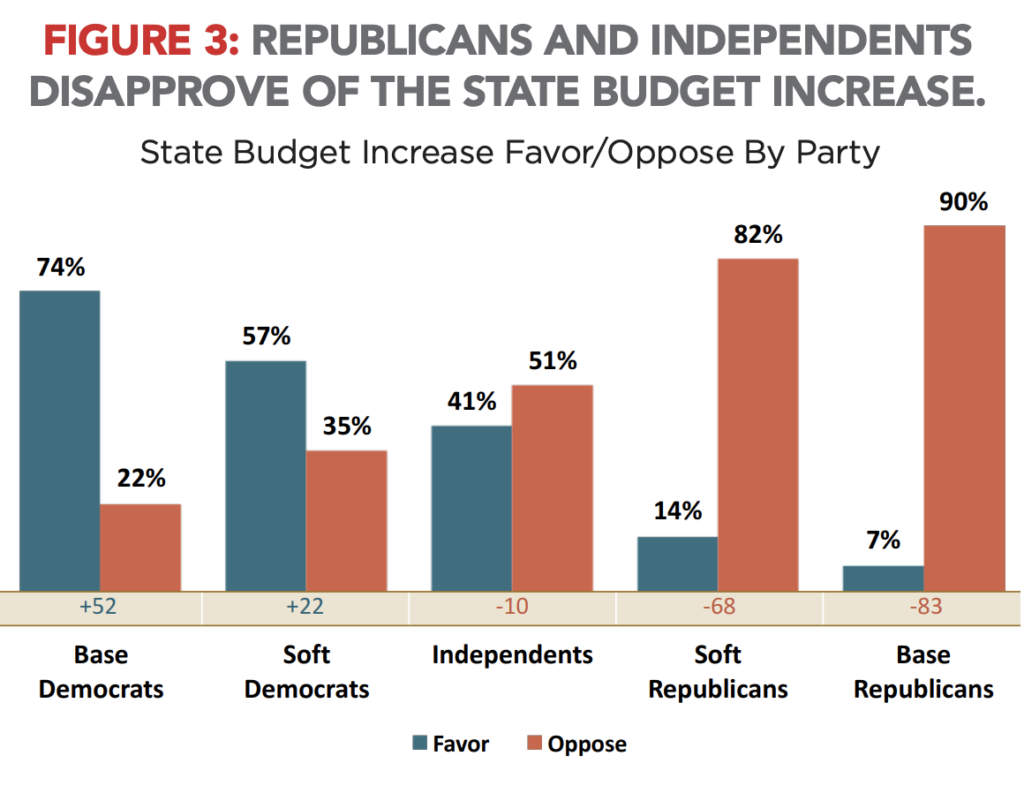

Energy Mandates
DFL lawmakers are pushing legislation that would compel 50 percent of Minnesota’s electricity to come from renewable resources by 2030. The Walz agenda includes his own version of the Green New Deal that has proposed mandating a 100 percent carbon-free electric grid by 2050. A study by Center of the American Experiment (see, “Doubling Down on Failure” on page 38) concluded that the 50 percent mandate will cost each Minnesota family $1,200 per year through 2030 and would result in no measurable decrease in global warming.
In all, 55 percent of Minnesotans surveyed said they were not willing to pay that premium. Sixty one percent of those not willing said they would pay “nothing” annually to combat climate change. While Democrats were generally supportive of the effort, Republicans adamantly spurned it. Independents also spurned the personal cost by 20 percentage points, 60 percent to 40 percent. While voters in the Twin Cities endorsed the concept 59 percent to 41 percent, voters elsewhere rejected the idea by wide margins.
Voters increased their dislike for the legislation when confronted with the Center’s conclusion that a 100 percent energy mandate would only reduce climate change by 0.00073 degrees C by the year 2100. Armed with that information, 63 percent of Minnesotans said they would be less likely to support the mandate. Even more—71 percent—of respondents said they would reject the legislation when told that one local school district would have to lay off 10 teachers to make up for the resulting higher electrical prices from the legislation.
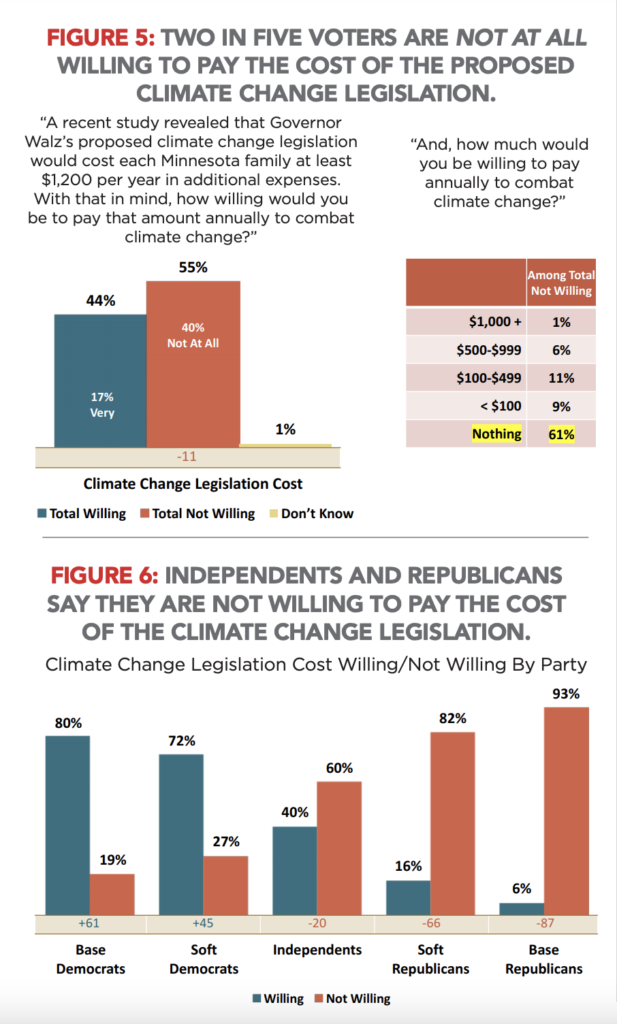
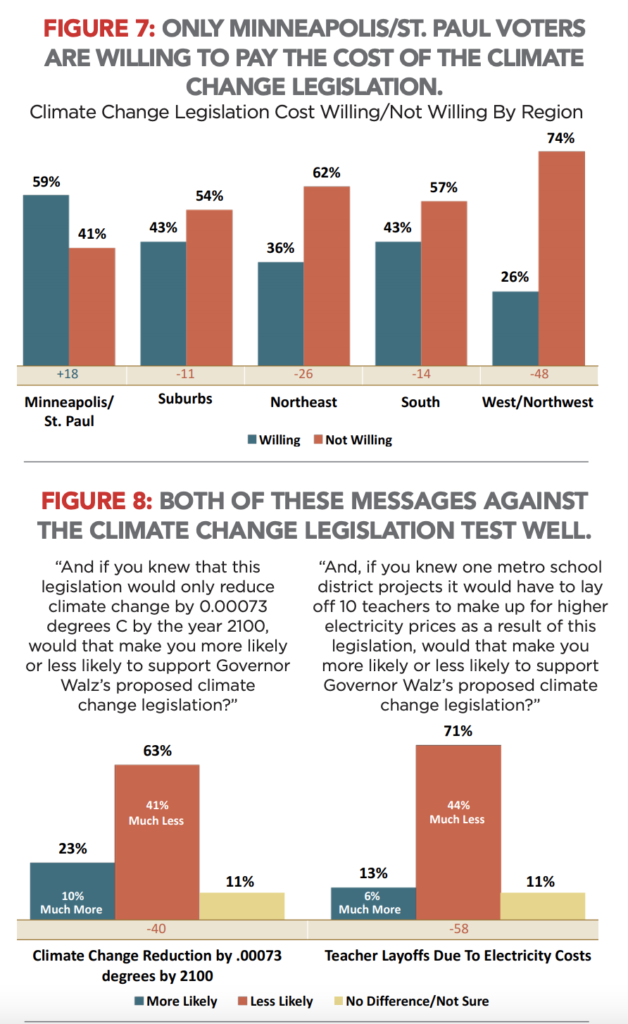
Wind
While generally supportive of wind energy (92 percent), a whopping 63 percent changed their minds when told that a local utility had “required residents to set their thermostats to 60 degrees and stop using hot water because the wind wasn’t blowing.”
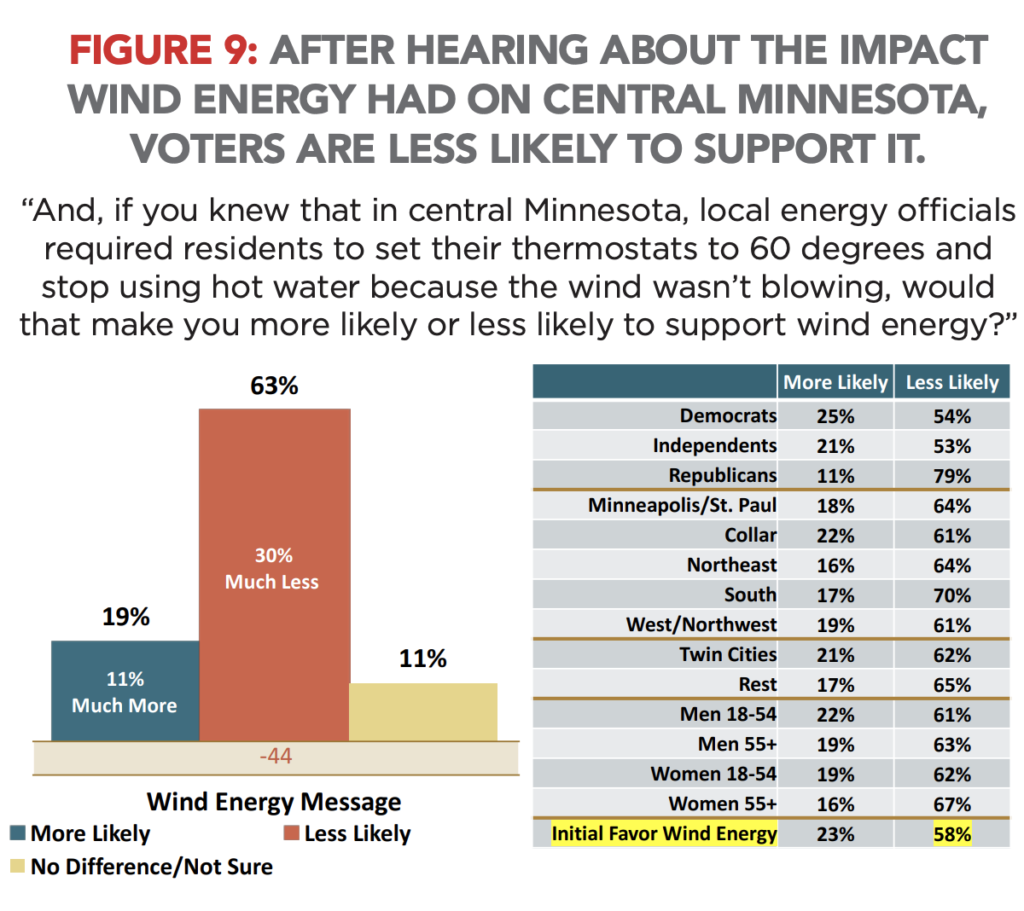
“Right Direction/ Wrong Track”
Minnesota voters are diametrically opposed in their optimism about the country and their opinions about their state.
The country, they say, is on the wrong track, by a margin of 59 percent to 36 percent. The partisan split is wide: Republicans are considerably more bullish (79 percent “right direction” to 13 percent “wrong track”) than either Independents (21 percent to 75 percent) or Democrats (7 percent to 89 percent). The Twin Cities (28 percent to 67 percent) and suburban women aged 18 to 54 lead the pessimists (24 percent to 71 percent). Residents of southern Minnesota are most optimistic (59 percent to 37 percent).
Minnesotans are more positive about the direction of the state, by a margin of 57 percent to 38 percent, although the “wrong track” sentiment has risen 12 percentage points from March 2018. Republican attitudes are far more negative (28 percent to 69 percent), while Democrats register dramatically more optimism about the state (85 percent to 12 percent). Independents come in at the middle (37 percent to 55 percent). Residents of the urban Twin Cities and women aged 18 to 54 are the leading “right direction” exponents about Minnesota, at 71 percent to 23 percent and 71 percent to 24 percent, respectively.
Tim Walz
First term Governor Tim Walz is generally well-known and well-liked by voters, although many describe him as being less conservative than themselves. Fifty percent have a favorable impression of Walz (22 percent “strongly”), while 28 percent think of him unfavorably (15 percent “strongly”). His strongest base of support is in the urban core of the Twin Cities (78 percent to 5 percent favorable/unfavorable); women aged 18 to 54 give him the highest marks among demographic groups (55 percent to 18 percent).
Most voters say Walz is less conservative or more liberal than voters’ own ideology. Sixteen percent say he is “more conservative”; 22 percent say he is “the same”; while 46 percent say he is “less conservative.”